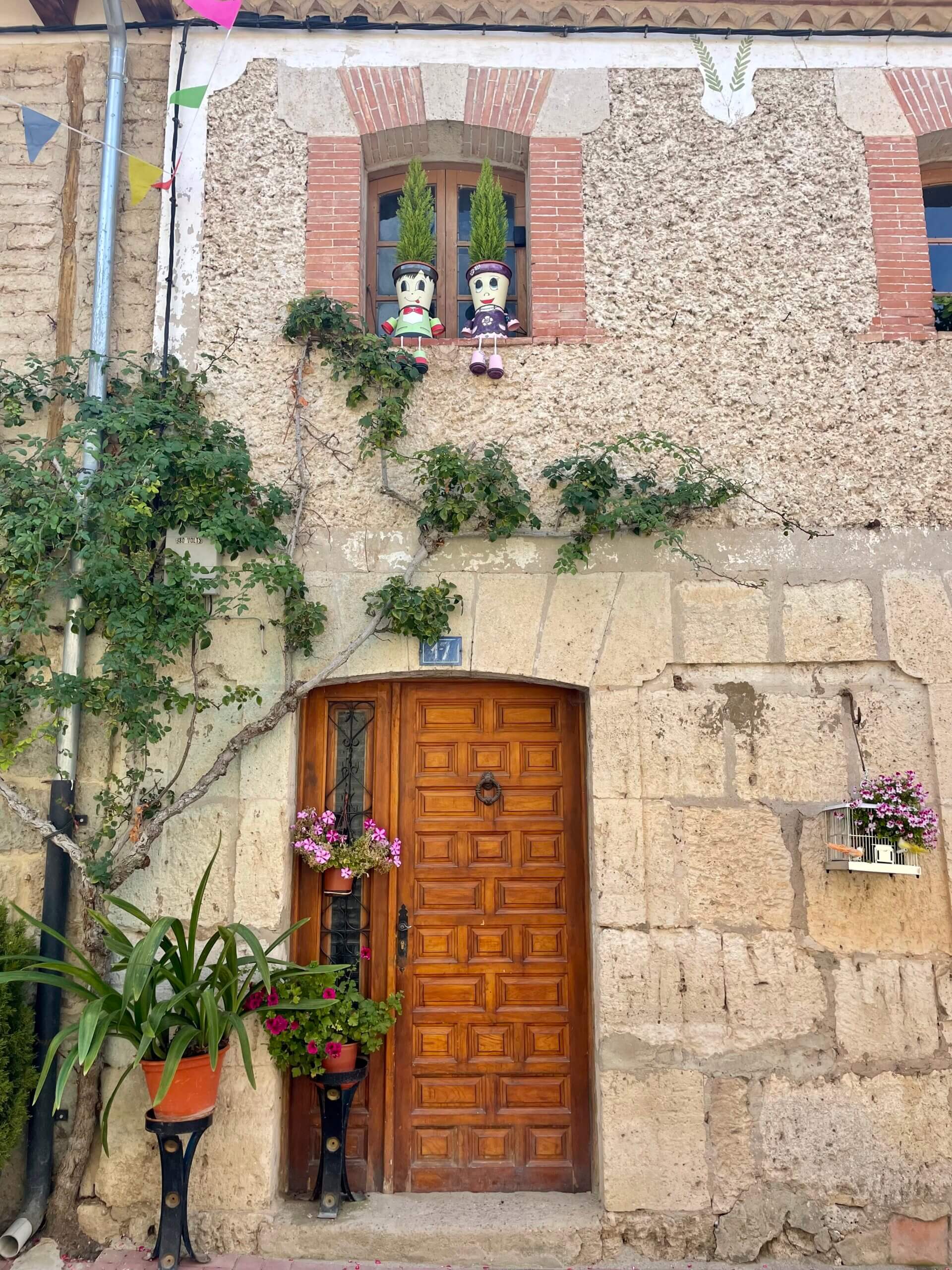
Camino de Santiago Accommodation: Where to Stay on ‘The Way’
Today we are talking accommodation on the Camino de Santiago—Where to stay on your Way.
If you’ll be walking the Camino de Santiago, read on for information about the different types of accommodation on the Camino de Santiago, albergue etiquette, and tips for sleeping like a pro on the Camino.
I completed the Camino Frances, or “The French Way” in the fall of 2022 and stayed at all different types of accommodation—albergues, hostels, hotels, and Airbnbs. While this post can serve as a good general overview of accommodation on the Camino de Santiago, it will be most helpful if you are walking the Camino Frances.
If you’re wondering why I’m posting so much Camino content lately, it’s because we are in the throws of Camino season and because my best friend’s dad is heading off to do his first Camino in September. I want to give him all the information I have, and why shouldn’t I offer it up to everyone?
Now, without further ado, let’s get into the meat. Here is everything you need to know about accommodation on the Camino de Santiago.
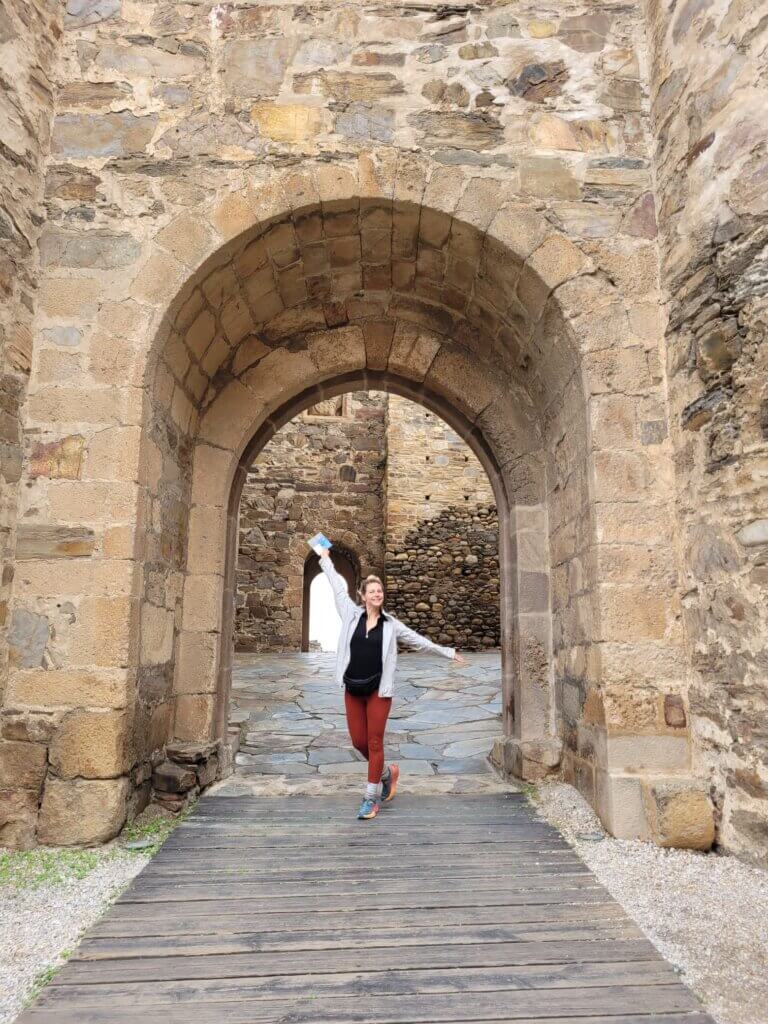
Get in loser, we're going on the Camino de Santiago.
Contents
This post is chock-full of info and might be a tad long. Here are the categories so you can click through to the info you’re looking for.
*Note: I won’t be giving any background info about the Camino de Santiago. If you don’t know what it is, check out this post from last year or some of my other Camino content where it is discussed in detail.
-Types of Accommodation on the Camino de Santiago
-Should You Book Accommodation in Advance?
-How To Book Accommodation on The Camino de Santiago
-What Are Albergues?
-Albergue Etiquette
-Sleep Tips for The Camino de Santiago
-Best & Worst Stays on the Camino Frances
-The Importance of Treat Yo-self Stays
-Conclusion
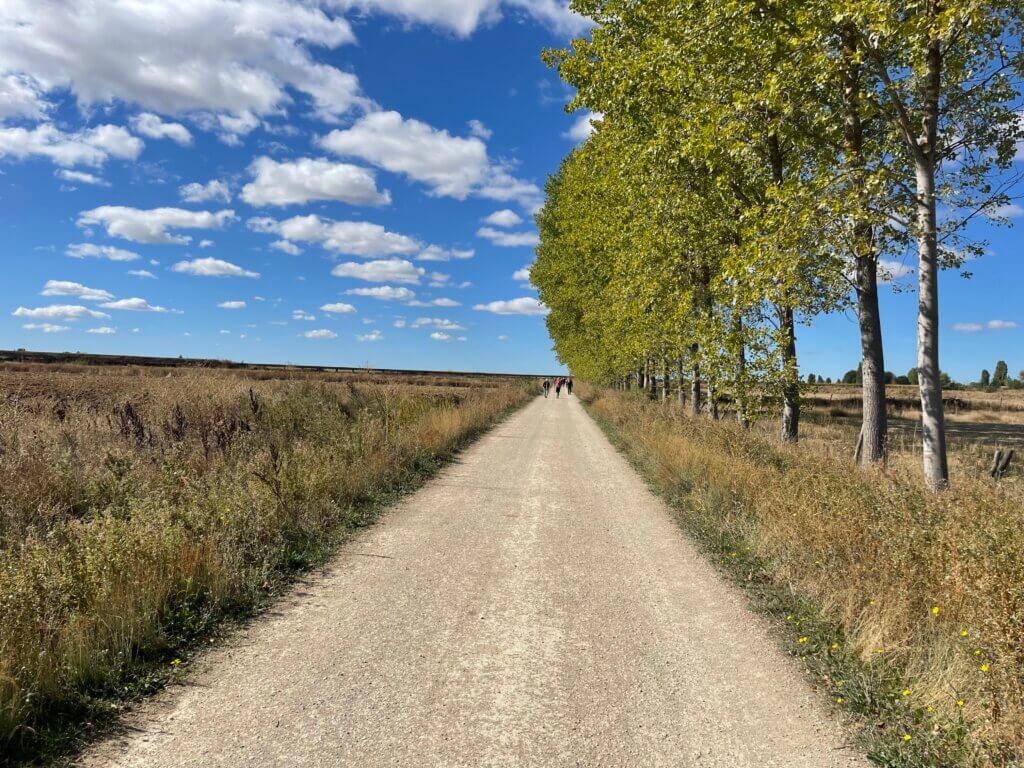
Accommodation on the Camino de Santiago
Where to Stay on ‘The Way’
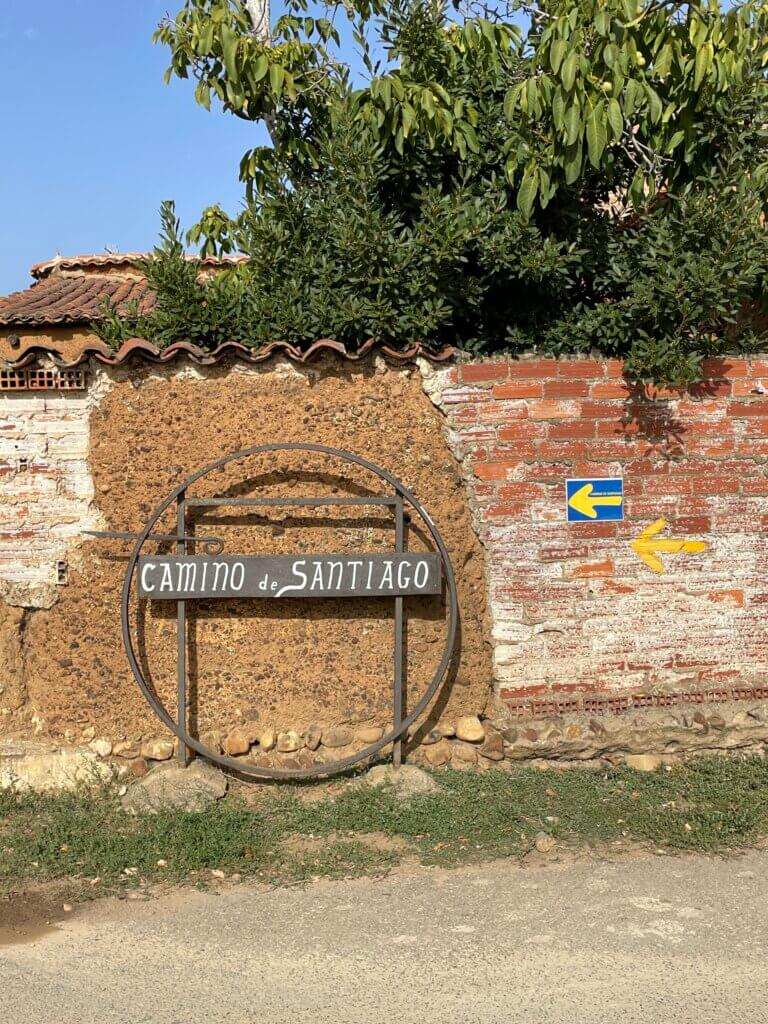
Types of Accommodation on the Camino de Santiago
There are several options for accommodation style on the Camino de Santiago. You can stay in private, fancy hotel rooms or in shared albergues with 120 beds and no walls. There is accommodation for every budget and comfort level.
Accommodation on the CasminoCamino de Santiago includes:
- Albergues
- Hostels
- Pensiones—These are a step between hostel and hotel. Think budget hotel option, usually run by an individual or family.
- Hotels
- Airbnbs/Vacation Rentals—This is generally only an option in the bigger cities.
- Camping—*Technically you’re not supposed to camp on the Camino Francés, but some of the albergues will allow it in the backyard. And everything is allowed if you don’t get caught. But don’t tell them I told you that.
I’m going to spend most of this post talking about albergues. This is because:
- Most of us know how to find, book, and stay in hotels, hostels, and Airbnbs. It’s pretty self-explanatory.
- Albergues are the most typical pilgrim accommodation on the Camino de Santiago.
- Albergues are where I stayed most often.
- They are unique to the Camino de Santiago, and therefore people are likely to have questions about them.
But before I get into that, I want to say that however you choose to do the Camino de Santiago is valid. Some purists like to tell people that only those who stay in albergues and carry their packs the whole way are “real” pilgrims. I do think everyone should try an albergue at least once, because it is a part of the experience worth having. It is a good way to gain a sense of community with other pilgrims, to exercise the principal of living with less, and to push oneself squarely out of one’s comfort zone. But ultimately, I believe that every person’s Camino is their own. Stay where you want to stay, send your pack ahead if you need to—or want to. You’re the only one who knows the “why” of your Camino, you only have yourself to impress. answer to. Do what you feel is best.
I planned to stay in albergues for most of the Camino, but to treat myself to private rooms or hotels in the big cities—Pamplona, Burgos, Leon. Halfway through the Camino, though, when I stumbled into a romantic relationship, things changed. The ratio flipped and it was private rooms most nights, with the occasional night in an albergue. At that point, staying in albergues was only a means to socialize, to assure ourselves that we hadn’t lost touch—with the other pilgrims, and with our own ideals for our respective Caminos.
Your wants and needs might change along the way, and that’s okay!
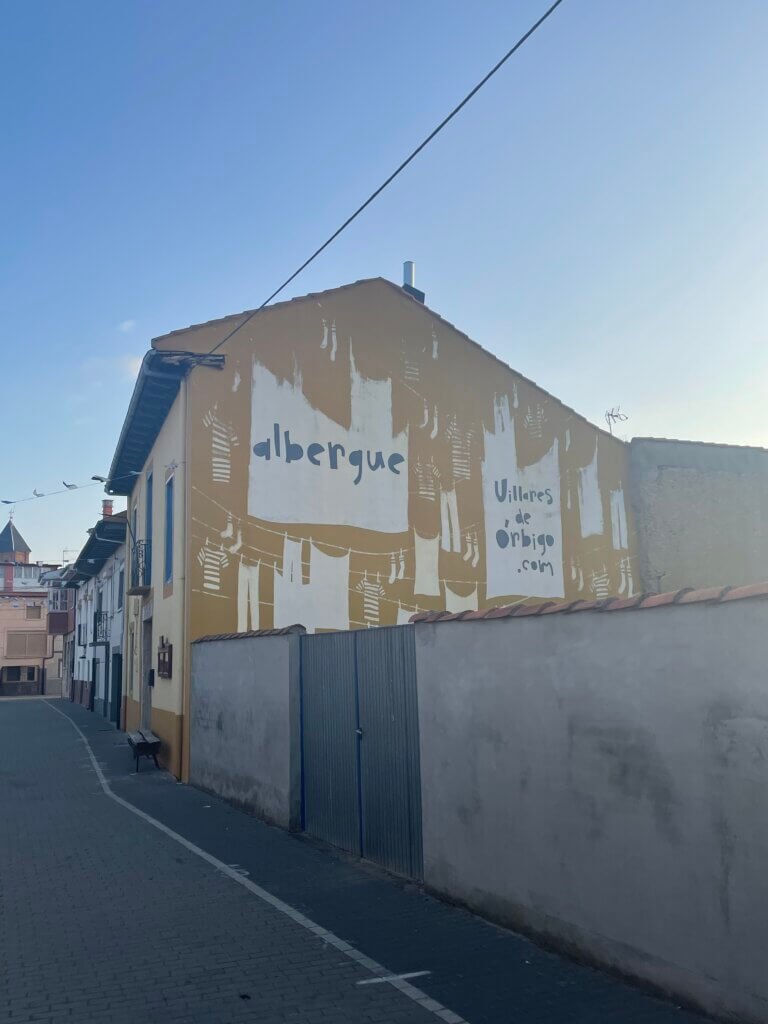
To Book or Not to Book
There is much debate over whether someone should book rooms in advance on the Camino de Santiago or decide along the way where to stay. There are pros and cons to both.
Booking in advance can feel antithetical to the Camino spirit. “The Camino provides” is a popular saying amongst pilgrims and learning to trust and believe this is a big part of the Camino experience. Regardless of your own affiliations or reasons for walking, the Camino de Santiago began and remains a religious pilgrimage; Faith is part of the deal.
Some folks feel that having to make it to a specific destination each night (because you’ve booked in advance) takes some of the freedom out of the experience.
That being said, the benefit of booking ahead is that you never have to rush. Showing up to a town and hoping to find an available bed is risky, especially if you plan to stay in municipal albergues. These fill up first, and there can be lines of pilgrims waiting at check-in time. During very busy periods on the Camino, like last September, when I walked, there can be a “Race to the beds” which involves everyone getting up earlier and walking faster to secure a bed at the next stopping point. This was how the first 3-5 days of my Camino Frances went, but thankfully, after a few days, things calmed down. Everyone seemed to take a deep breath and settle into their own pace.
Don’t let this scare you. Most of the time you will be able to find accommodation without booking ahead. If you’re not able to, you just walk to the next town. It’s all a part of the adventure!
*If you are planning to have your pack shipped ahead, you will have to book your stays in advance.
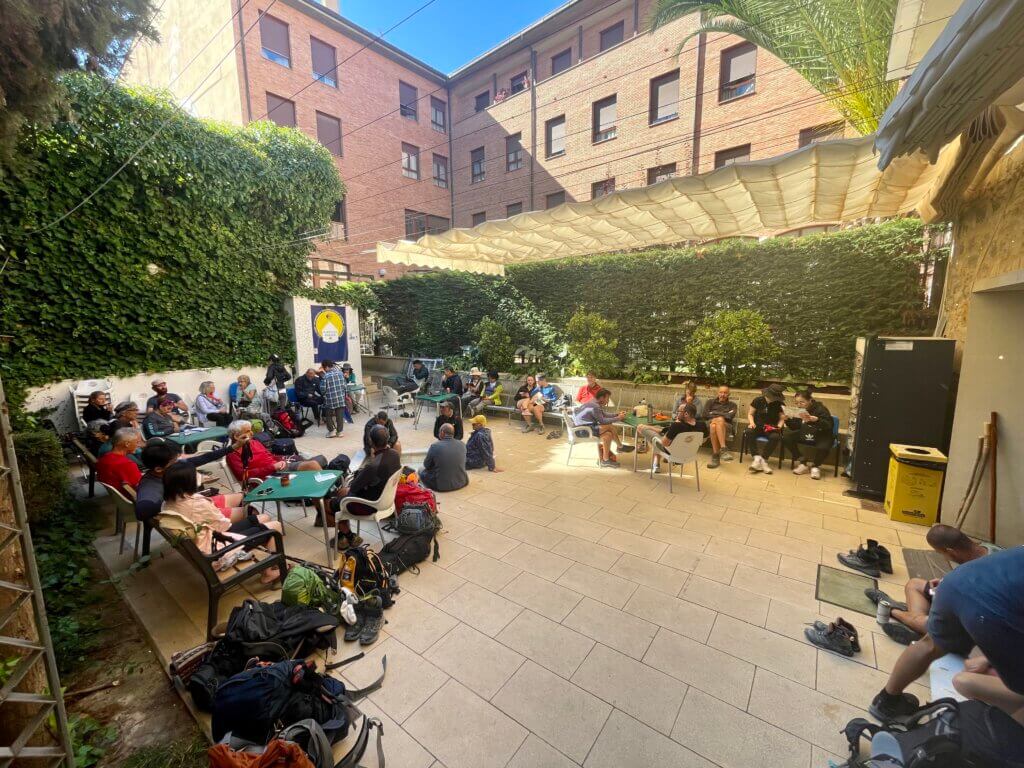
It was a race to the beds in Logroño
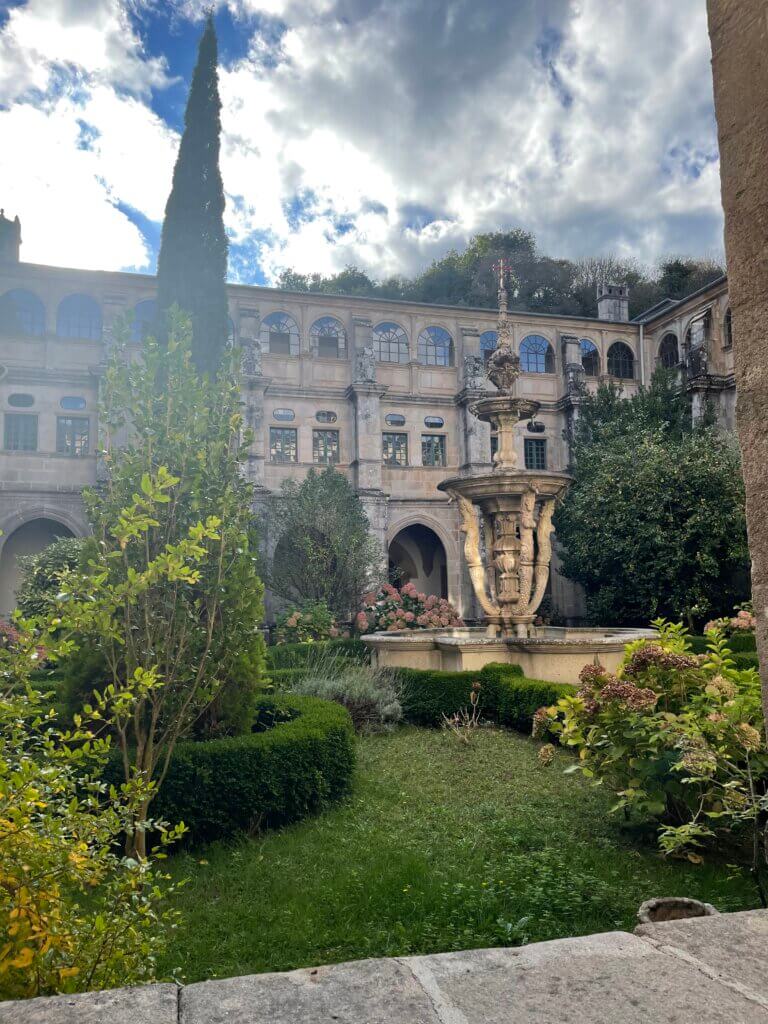
Parochial albergues are usually connected to or affiliated with a church
Booking Accommodation on the Camino de Santiago
I used the Camino Ninja App on my Camino and am convinced it was the best Camino app out there. It had info on accommodation in each village along the way, including prices, amenities and reviews, a map to prevent getting lost, and even booking capabilities.
Sadly, the creator of the Camino Ninja App died last year, in Leon, while doing what he loved most—walking the Camino. The app was still available for a while, but has since been pulled from Google and Apple app stores. I am sorry to say I don’t know of another app that is as good to recommend. Check message boards or app reviews
Many places along the Camino are like being in a time capsule—no websites, no reservations, cash only. But since the Pandemic, more and more have modernized. Booking.com was the best site for booking accommodation on the Camino de Santiago. Hotels, Pensiones, Hostels, and even some albergues can be booked on the site. Many also take reservations via WhatsApp call or text message.

All About Albergues
Now, what the heck is an albergue?
Albergues are the most common and traditional form of accommodation on the Camino de Santiago. As mentioned before, albergues bring together some important ideals of the Camino de Santiago—community, stepping out of our comfort zone, and living with less.
An albergue is a hostel, but one that only allows pilgrims walking the Camino to stay there. You are required to show your Camino credential and you get a stamp each day at your albergue. The cost of staying in an albergue will range from €8-20 per night, unless you are staying in a donativo. (More on that later.)
Unlike a hostel, albergues have strict quiet hours, beginning at 9 or 10pm, and exit/entry is not permitted during these hours. There is often a cheap ‘pilgrim meal’ offered in the evening, and this is a great way to meet others walking the Camino. Some albergues have washing machines for a fee, but many pilgrims don’t bother. Instead, they use the washing sinks to hand wash the few items they wore that day. Every albergue I stayed in had a washing sink for laundry and lines to hang clothing.
Sharing is caring at an albergue. You will be sharing a few bathrooms and showers amongst many people. You may have to wait, but this is part of the experience. You will share a room with a lots of other people. And you will sleep in bunkbeds. Most of the albergues I stayed in were completely co-ed, bedrooms and bathrooms, but a few had separate rooms for men and women.
Some of the better albergues provide a simple breakfast and coffee in the morning, some do not. Some have kitchens you can use to cook yourself a meal. Some do not. Some will bring you, as a group, to mass at a nearby church. Some do not. The amenities offered and the quality of quarters vary greatly between different albergues.
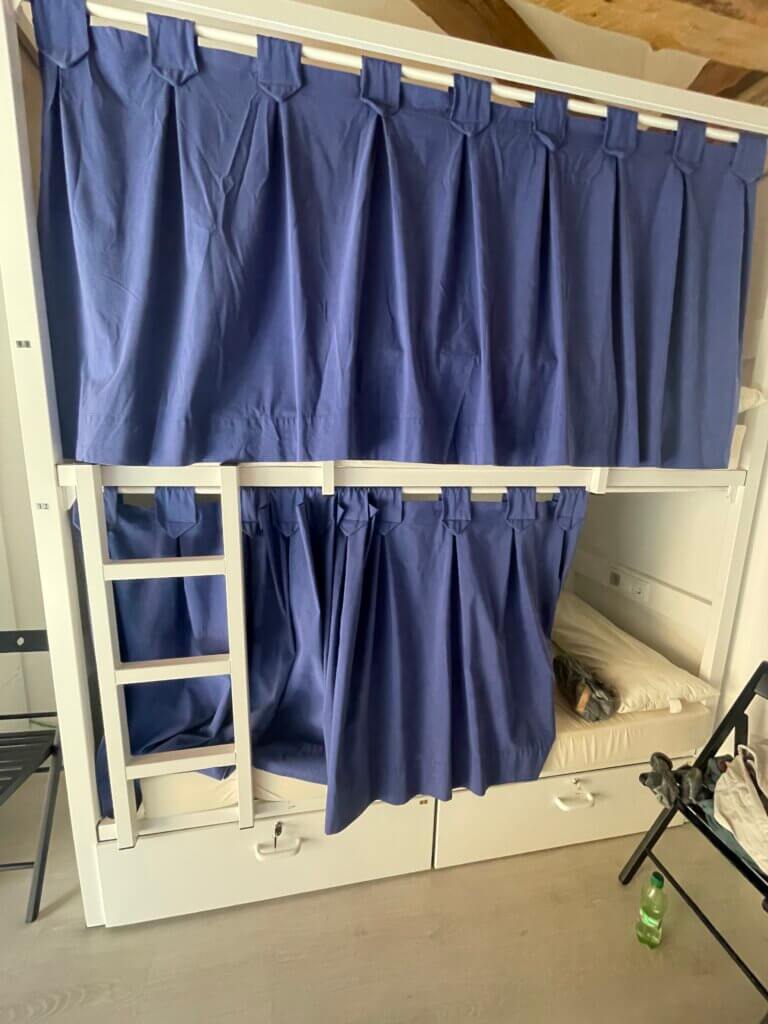
From one of my favorite albergues, in Hospital de Orbigo. Info below!
Types of Albergues
There are a few different types of albergues on the Camino de Santiago.
Municipal Albergues—These are run by the city or town. They get public funding and are the cheapest accommodation on the Camino de Santiago. Expect bunk beds and lots of people. Municipal albergues generally do not accept reservations. The beds are awarded on a first-come-first-serve basis, so you may want to get there early.
Private Albergues—These albergues belong to and are run by a person, family, or company. They tend to be smaller than the municipal albergues and may be a bit more expensive. Some private albergues must be booked in person, but many can now be booked using Booking.com or WhatsApp. Check Camino apps for information on the albergues available at your next destination.
Donativos—These parochial albergues are usually connected to a church and they run on—you guessed it—donations. Technically you can stay here for free, but these albergues survive on pilgrim donations and volunteers, and most are very good. It is recommended to pay what you would at another albergue.
Donativos or parochial albergues are basic, often having mats on the floor instead of beds. And yet, they are some of the best ones to stay in for many pilgrims. The experience is more personal, more giving. Donativos often provide a free community dinner for the pilgrims and some kind of “get to know you” activity or conversation. It’s a whole thing, not just a bed.
In my first parochial albergue stay, we the pilgrims chipped in to peel potatoes, chop veggies, and slice bread in preparation for a big dinner. While the volunteers finished cooking, our group of pilgrims attended mass at the church on the other side of the building. I’m not Catholic (or religious at all) but it was nice. The priest called the pilgrims to the front of the church, and we were all given a special blessing for our “Way”. After a dinner full of talking, and laughing, and lots of carbs, we all chipped in to wash the dishes together.
To close out the evening, we were invited to do an optional group meditation in the balcony of the church. I opted in, and it was one of my favorite parts of the experience. The meditation was candle-lit and quiet, as personal as each person wanted it to be. It ended with all of us hugging each other, one by one, around the room. I know this sounds awkward, but it was actually amazing. I hadn’t noticed the stark absence of physical touch throughout my time on the Camino, until I was locked in an embrace. And then another. Truthfully, for a girl who isn’t much of a hugger, this shuffling through a sea of arms and warmth, kind words and knowing looks, was profound.
I slept like a baby on my floor mat, and we were treated to a free pilgrim breakfast before starting our walk the next morning.
Everyone I know who has stayed in a parochial albergue says the same thing: it is the best experience they’ve had at an albergue. If you walk the Camino de Santiago, you must stay at least once at a parochial donativo albergue. The one I mentioned above is Albergue parroquial San Juan Bautista in Grañon, Spain. Stay here if you have the opportunity.
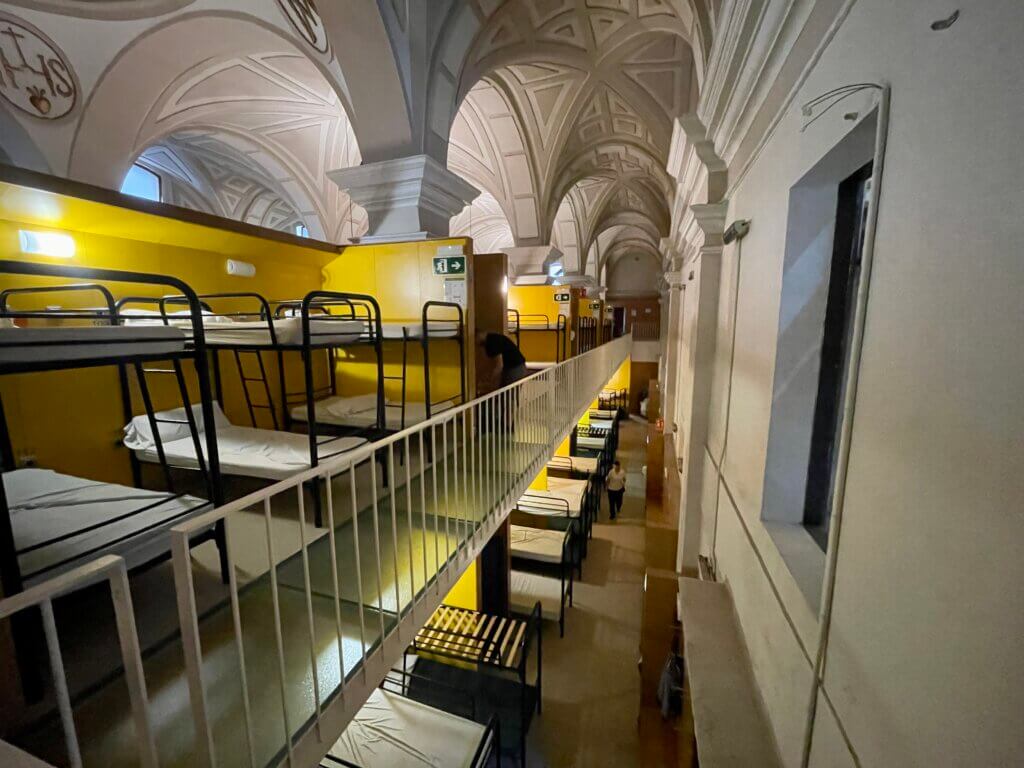
The 120-bed municipal albergue in Pamplona

Humble quarters in one of my favorite albergues on the Camino
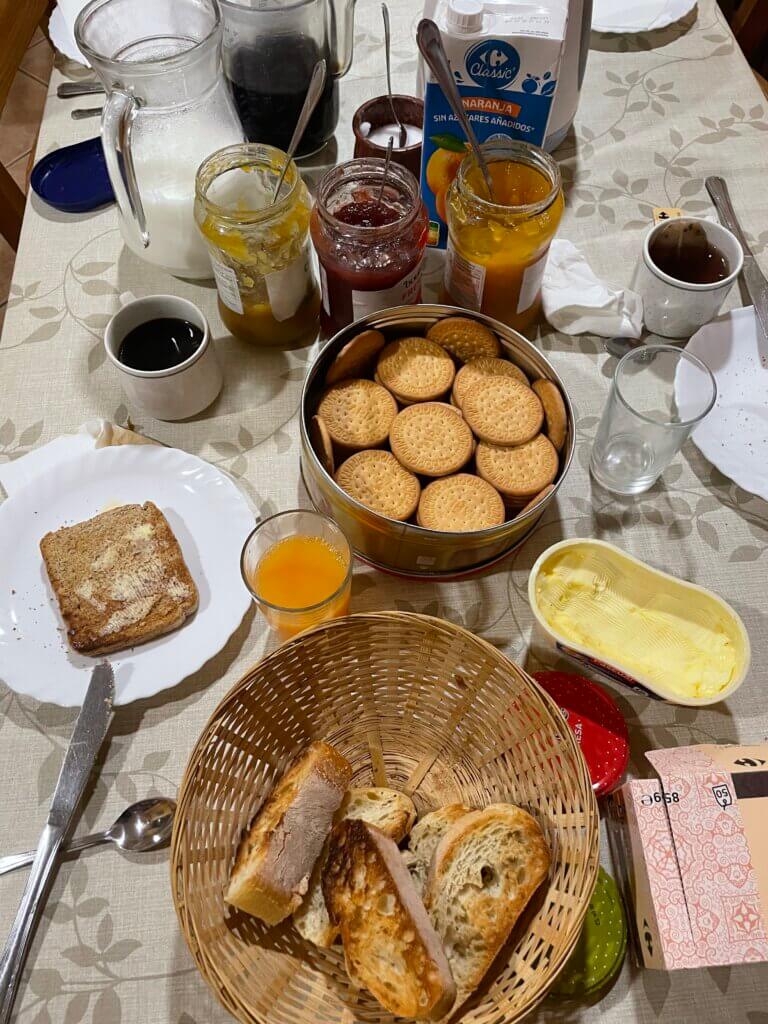
A simple breakfast at one of the albergues along The Way.
Albergue Etiquette on the Camino de Santiago
Now that we’ve gone over the types of albergues on the Camino de Santiago, let’s talk about best practices for staying in them.
When you’re sharing sleeping space with several, or dozens, or hundreds of strangers, it is important that everyone do their best to be courteous. Here are some albergue etiquette tips to make sure you’re not the worst person in the room.
1. Respect Quiet Hours
Most albergues have quiet hours from 10-6. They lock the doors and turn off the lights, and pilgrims are expected to go to sleep or at least be quiet. In general, talking is a huge no-no after quiet hours. If you must whisper to someone, then do it, but this is reserved for things like “Have you seen my phone?” “Are you almost ready to go?”, etc. Full conversations should not be happening during quiet hours, regardless of the volume.
In the morning, pack your things *quietly*. Tip toe around like you’re afraid of waking someone up—you should be! Once you’ve left the albergue, you can ruffle your loud bags and talk to your friends at full volume on the road.
2. Silent Alarms
Imagine 20 or more alarm clocks going off at once? Or worse—going off at 20 different times?! Sounds like a horrible room to be in, right? Set your alarm to vibrate and sleep with your phone in your bed. This is the best way to wake up when you want to do it without waking everyone else.
Not every albergue will have an outlet directly next to your bed, so make sure you charge your phone when you finish walking for the day.
3. Take your phone calls and loud conversations outside.
Think of the bedrooms of an albergue not like your bedroom at home, but like a room for sleeping and getting dressed ONLY. Go for a walk or find a quiet place outside to take calls. Many of the albergues I stayed in had a small courtyard with places to sit and relax and catch up.
4. No eating in bed.
Consume food in the kitchen, dining room, or courtyard area of your albergue, NOT the bedrooms. If every pilgrim ate in bed, there would be crumbs, bugs, and a giant mess for the already busy hospitaleros who run the place.
5. No Packs on the bed.
Your pack will be plopped on the ground more times than you can imagine throughout your days on the Camino. Keep the dirt and muck off the beds so they stay nice and clean for the next travelers.
6. No hiking shoes in the bedrooms or the showers.
Same deal. Your shoes will be filthy and it’s VERY uncool to track mud into the bedroom of an albergue. All of the albergues have shoe areas for you to leave your boots or sneakers, usually in the front, but sometimes on shelves by the rooms.
If you’re wearing sandals to hike, they should not be going in the shower with you. Instead, leave them with the other “outside shoes.” This is where a pair of cheap, light flip flops comes in handy.
7. No Sex
This probably goes without saying—I HOPE this goes without saying—but don’t do “it” in a shared room. This includes doing “it” with yourself.
If you can sneak in a very quick solo session in the shower and clean up after yourself, then go for it, but consider the beds in shared rooms to be off limits. *EVEN when no one else is in the room.* They could walk in at any moment, and you will be known far and wide as the Creep of the Camino.
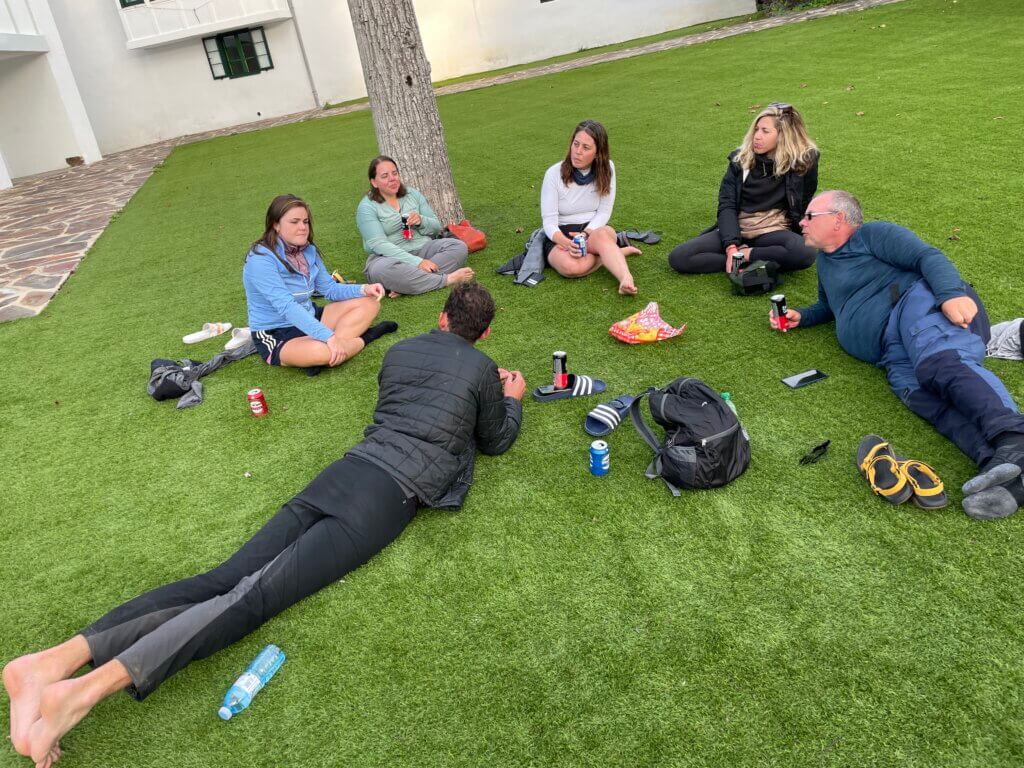
Socializing should happen outside of the dorm room.
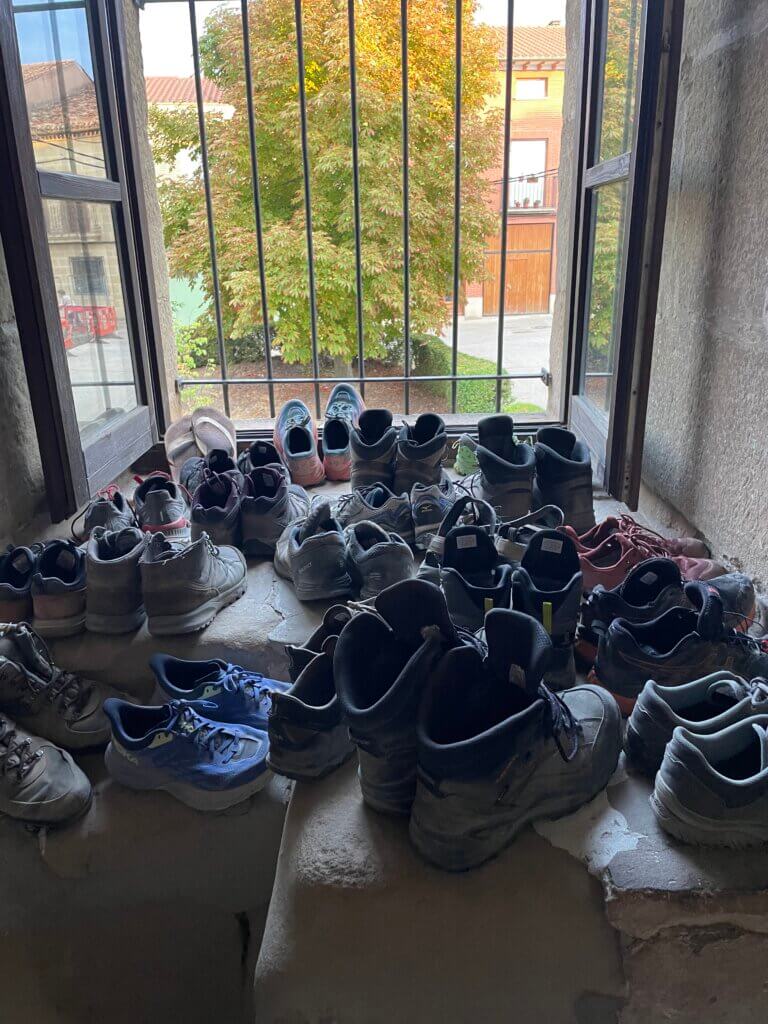
Hiking shoes inside the albergue is a BIG no-no.
Sleeping Tips for the Camino de Santiago
(How to Sleep better in Albergues)
Now that you know the rules of sleeping in albergues, let’s talk how to actually sleep in albergues. Here are my best tips for sleeping in albergues on the Camino de Santiago.
Let’s face it, sleeping in a room full of strangers can feel a bit weird. But if I got through it, you definitely can too.
I did not sleep more then 2 hours a night for my first three nights on the Camino de Santiago. I can be a high maintenance sleeper, even at home, but I was extra worried about the prospect of sharing a room with a million STRANGERS. As a perpetually single flight attendant, I’m always sleeping alone. I sleep alone at home, and then I go on work layovers and sleep alone in hotel rooms. The thought of dozing off to a chorus of breathing and snoring and, like, other people’s presence kind of freaked me out. (I am NOT down with OPP.) Here’s how I managed.
Sleep Essentials & Mitigation Tactics:
Sight: Sleep mask, obviously
Sound: Ear plugs or headphones, depending on preference.
People snore. They talk in their sleep, they breathe loudly, they get up in the night to use the bathroom, they toss and turn on squeaky bed frames. These are the realities of sleeping with strangers. Unless you are the heaviest sleeper in the world, you will need ear plugs or headphones to block out the sound.
During my Camino, I usually fell asleep listening to a sleepy playlist or an audiobook. An audiobook with a sleep timer was a great way for me to distract myself from my surroundings, and listening to a bit of a book each night became a sort of bedtime routine. If you’re a fussy sleeper like me, routines are critical in the quest for sleep. Each piece of your bedtime routine sends a signal to your brain to start relaxing. “We’re winding down,” it says.
As a random, personal tip, I find that ear buds—and ear plugs for that matter—hurt my ears if I lay my head on them. So, when I use them for sleep, I only use one. The ear against my pillow is always empty and the other catches the winding words of Ann Patchett or V.E. Schwab through my ear bud.
Temperature: Layers, baby!
Being too hot or too cold makes sleeping impossible. I layered up my silk sleep sack and sleeping bag, so that I could easily switch during the night if I became too hot or too cold. I layered my fleece and wool socks on cold nights, and stripped down to my underwear on the hot ones.
The Secret Weapon: Drugs
Calm down, we’re talking Melatonin. I never take “real” sleep drugs because I’m afraid of getting addicted and making my already hard time falling asleep even worse. Melatonin is plenty strong enough for me, and I took it about 1/3-1/2 the nights on the Camino.
Brain Trick for Sleeping: Be organized.
Weird take, I know, but knowing where all your stuff is will reduce anxiety and help you to sleep easier. Before bed I would fill my water bladder and pack as much as possible so that the morning could be quick and quiet. I kept all my sleep essentials in a little mesh bag and rolled them up into my sleep sack. They were never missing. I slept with my fanny pack clipped to my bed. This contained my passport, Camino credential, money, chapstick, and ear bud case. Having these important items in bed with me meant I didn’t have to worry about them going missing or getting lost.
I didn’t encounter any theft or suspicious behavior at albergues during my Camino, but in a human endeavor there is always room for bad behavior. You should have your passport and cash on you at all times.
Give it time.
If you’re worried about being able to sleep in Albergues, I don’t blame you. I was nervous, too before going. And I was in a walking dead despair on Day 3 after not sleeping at all the first two nights on the Camino de Santiago. But after that, things got better. I got my hands on some precious melatonin. I started listening to my audiobook at night. Eventually, I even started getting used to the whole sleeping with a million strangers thing.
One of the coolest takeaways from the Camino de Santiago was becoming a better sleeper. I almost never have sleepless nights now. I still use a sleep mask sometimes and I often listen to audiobooks before bed. But these little tricks were tried and tested on the Camino, and I basically have a fool-proof formula for getting the ZZZs in.
It may be tough for the first couple of days, but believe me, you will sleep. Walking 10 or 15 or 20 miles in a day is work, no matter how fit you are. And being outside all day, exposed to the elements—the rain or wind, the frigid mornings or blazing, dusty afternoons—is exhausting. Eventually, your body will sleep. Use these simple sleep tips, or come up with routines and hacks of your own.

A little added privacy is sure to help you sleep.
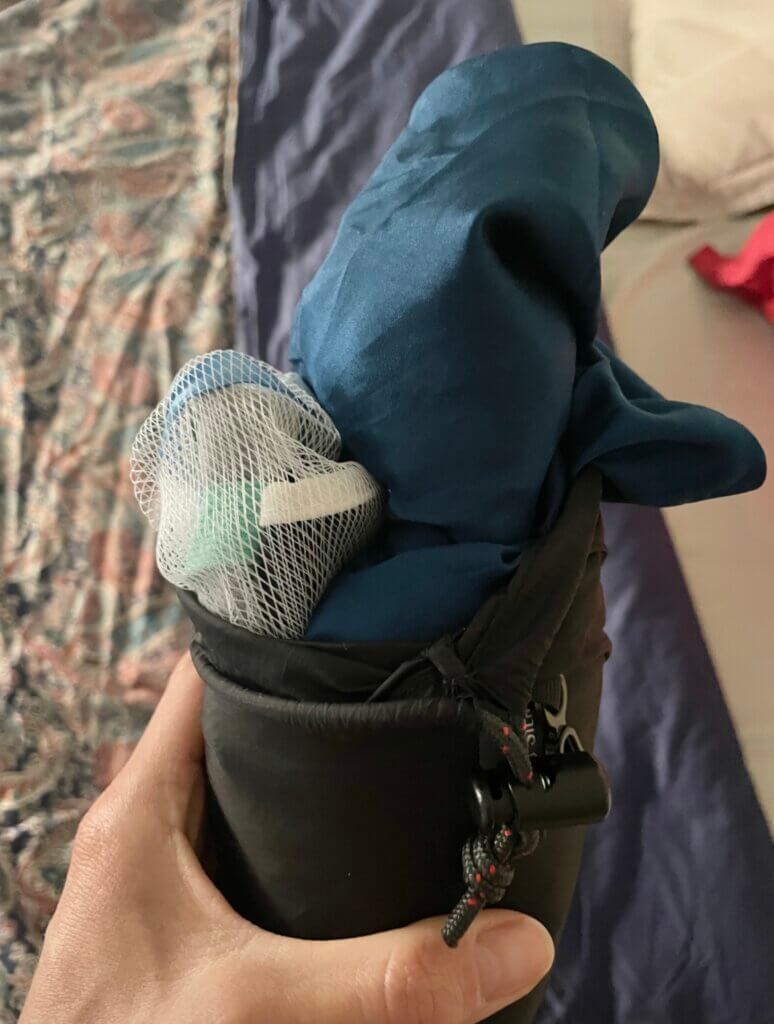
Keeping your things organized will help you fall asleep & rest easy on the Camino de Santiago.
Best and Worst Accommodation on the Camino Frances
Over 35 days, I stayed in too many places to remember them all. But some stand out, for better or worse. Here are some of my favorite and least favorite hotels, albergues, and other accommodation on the Camino Frances.
Best Accommodation on The Camino:
Hospital de Peregrinos San Juan Bautista, Grañon—I wont give more details since I went over this one already in the “Donativo” section above.
Hotel Paris, Leon—This place was a splurge in a time when I needed it most. I upgraded to a suite that contained a deep, jetted jacuzzi tub in the bathroom and skylights in the vast expanse of bedroom. I booked a spa treatment at the attached facility, which was worth every penny. There is a swanky restaurant and café at lobby level.
El Descanso de Wendy, Astorga – This was a splurge born of a need to be alone (together) and a lack of available options. I’m so glad we stayed here. The room was enormous and furnished like old money with eclectic style. There was a small kitchenette outside our room that was stocked with cookies, tea, coffee, and bottled water, and a little terrace overlooking the city. A full-service hot breakfast was included, and we felt like very fancy people, indeed.
Casa de los Hidalgos, Hospital de Orbigo—I found myself in Hospital de Orbigo, Spain with no cash, in a town that has not a single ATM. I had to stay in an albergue that accepted cards, and this one was SO good. The rooms are clean and modern. The bunks have privacy curtains, and each individual bed has its own set of outlets and nightlights. Genius! The bathrooms were clean and the shower had three different jets for a spa-like experience. Breakfast was included in the price, and there was a very cute courtyard to sit in.
My Worst Stays on the Camino
Albergue San Pelayo, Villarente—My friends and I referred to this albergue, for the remainder of the Camino, as “The Smelly Place.” It wasn’t bad otherwise, but the aromas wafting from the bathroom were so pungent that it nearly choked me in my sleep. To be fair, it could have been a plumbing issue that has since been fixed, but I wouldn’t take the chance again.
Pensión CHE, O Pedrouzo—If Albergue San Pelayo was The Smelly Place, Pension CHE will be known as The Wet Place. We were put in a room in the basement level and, after showering, the room and everything in it became wet. AND NEVER DRIED. The walls dripped, the sheets felt damp, and stepping out of bed onto the slick tile floor to go to the bathroom was taking your life in your hands. To give the benefit of the doubt, the rooms on higher floors may have been better, but who can say? The pool was closed when we went and there was no restaurant on site or in walking distance. Ironically, this was one of the more expensive places we stayed.
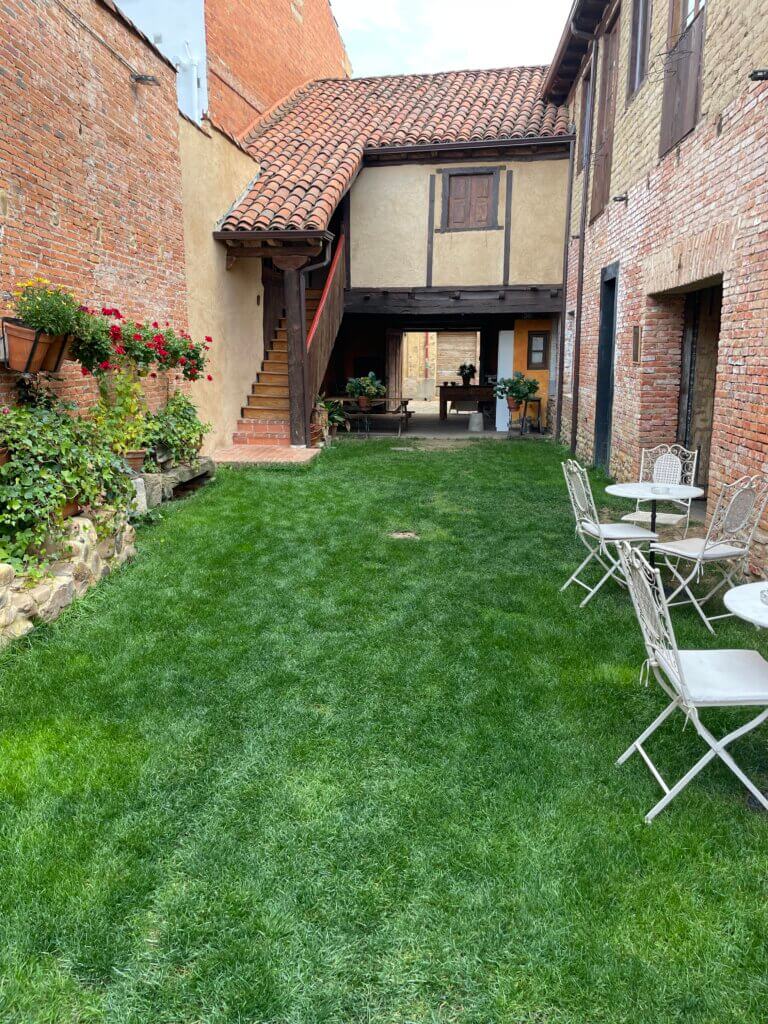
The cutest little courtyard at Casa de los Hidalgos
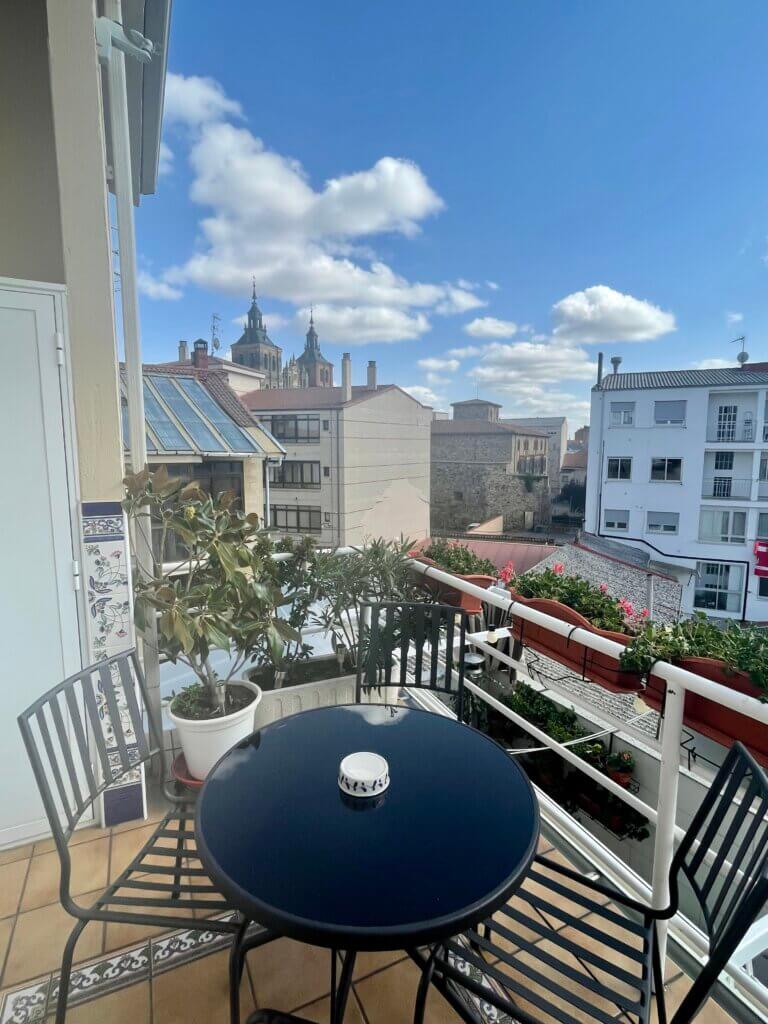
Our rooftop terrace at Descanso de Wendy in Astorga
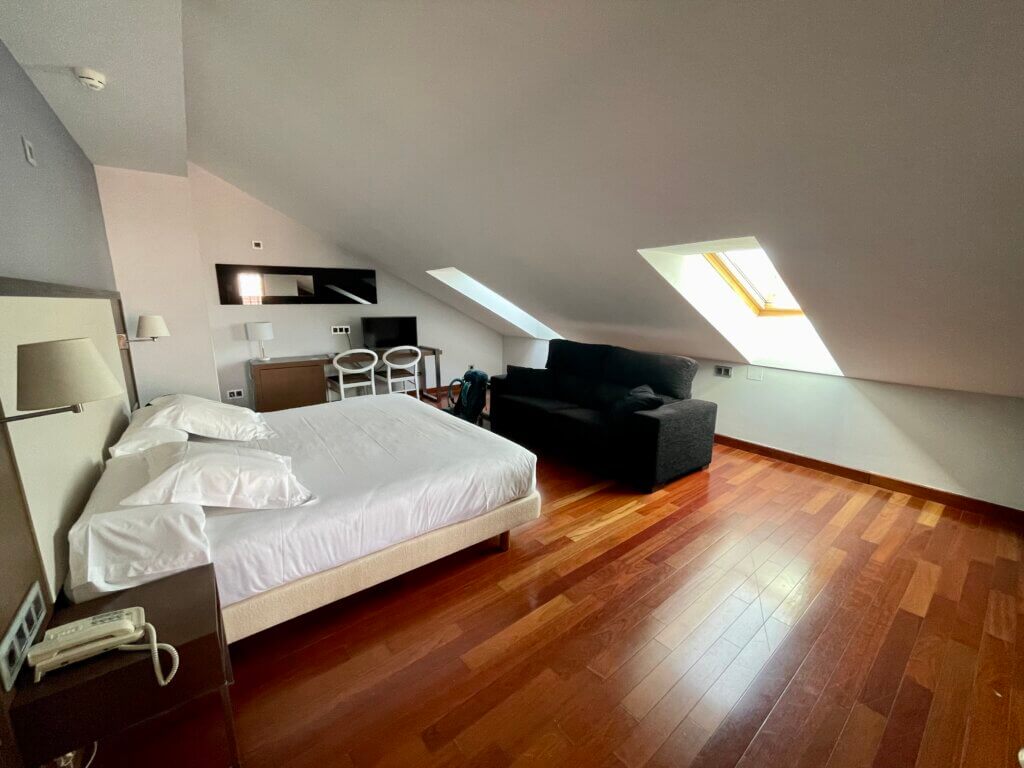
A giant suite to myself? You shouldn't have! (Hotel Paris in León)
Treat YoSelf
(It’s important!)
Looking at my best and worst list, you can see that I spent some time in nicer, “treat yourself” accommodation. And I think it’s important to do once in a while on the Camino.
Long before my whirlwind Camino romance began, I knew I would be treating myself to some “rest days” and nicer accommodation in the bigger cities. (I use the term “rest” loosely, because my days not walking the Camino were spent running around the big cities, sightseeing, shopping, and even dancing.)
Everyone must make their own way, but I suggest that you, too, take an extra night in the big cities along the French Way—Pamplona, Burgos, and Leon. I almost stayed an extra night in Astorga, too, but that is mostly because I was in the Love Bubble. (See more here.)
There are museums, good food, fun locals and tourists alike. You’re already there, why not stay a while?
In Pamplona, my stay fell during a busy weekend with multiple concerts and sporting events (like a rollerblading race, for example.) The prices for hotels were crazy expensive, so I stayed one night in the municipal albergue and the second night in a private room in an Airbnb. It was terribly expensive—like two weeks’ worth of albergues—but, after sleeping poorly in the beginning of the Camino, I desperately needed a night to myself.
My Airbnb host was awesome. He took me out to lunch to sample some local cuisine. I had coffee and pastries, talked language and culture with him and his father in their parlor overlooking the Plaza de las Merindades—a perfect view if you’re in town for the Running of the Bulls. Later that night, we hit a bar together and had such a great time chatting we stayed out until midnight. By the time I left Pamplona I felt like I’d made friends.
In Burgos, I booked two nights in a private room in a hostel that was close to all the city’s attractions. It didn’t have a private bathroom, but at least I could sleep naked, undisturbed by snoring, and masturbate if I wanted to. Stay on the Camino de Santiago long enough and the littlest things start to feel like princess-level luxury.
In León, I stayed at ARVA Spa Paris, a swanky hotel, at least by Camino standards, with a pool and spa attached. This was the point at which I needed a real break from the Camino—from the food, the clothes, the walking, all of it. I booked myself a treatment in the water spa and followed that with an hour-long massage. I sat in my deep, jetted tub, sipping Pellegrino and eating fresh peaches and brie—the luxuries one can purchase in a big city. I dressed in my least pilgrim-y outfit, and I debuted the lipstick I’d been carrying in the bottom of my toiletry case for weeks.
I met a boy. I went on a first date. I ate sweet, spicy, delicious THAI food. I drank non-alcoholic beers and danced, while a live band played onstage. I stayed out until 3 am. I ordered cappuccinos and chocolate croissants from the café in my hotel lobby and felt as if I were in New York or Amsterdam, San Francisco or Paris. My longings for the creature comforts of a big city, for the flavors of something other than Spanish tortilla, to look and feel like myself outside of the Camino—were all assuaged in Leon.
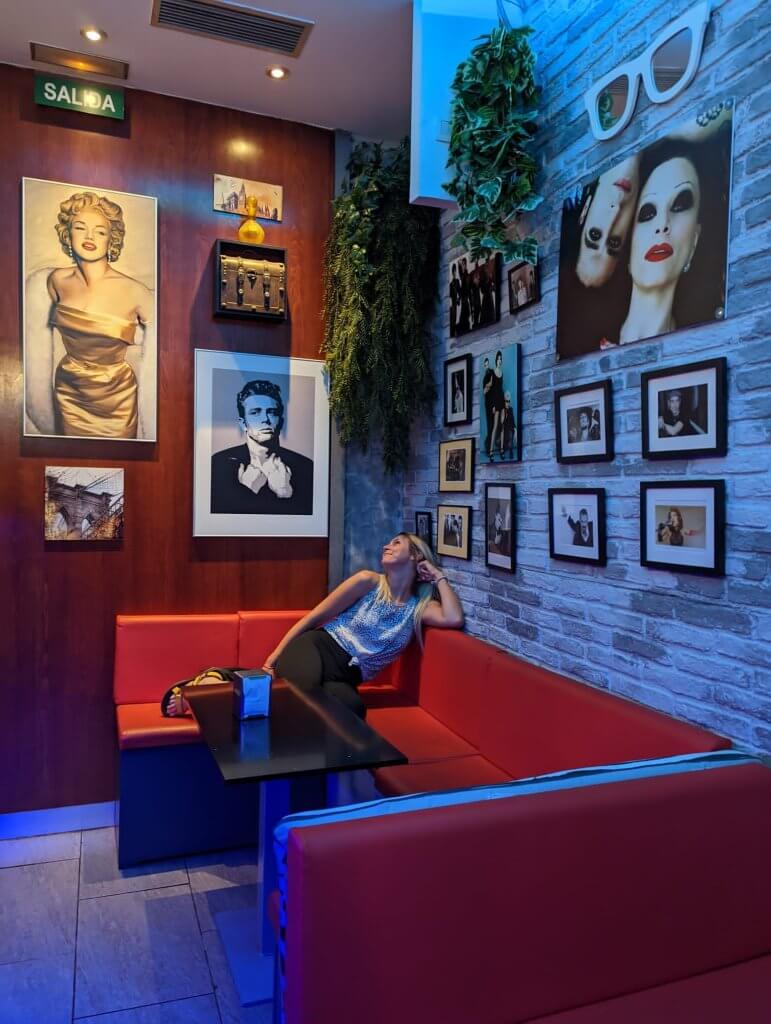
Pilgrim? What pilgrim?
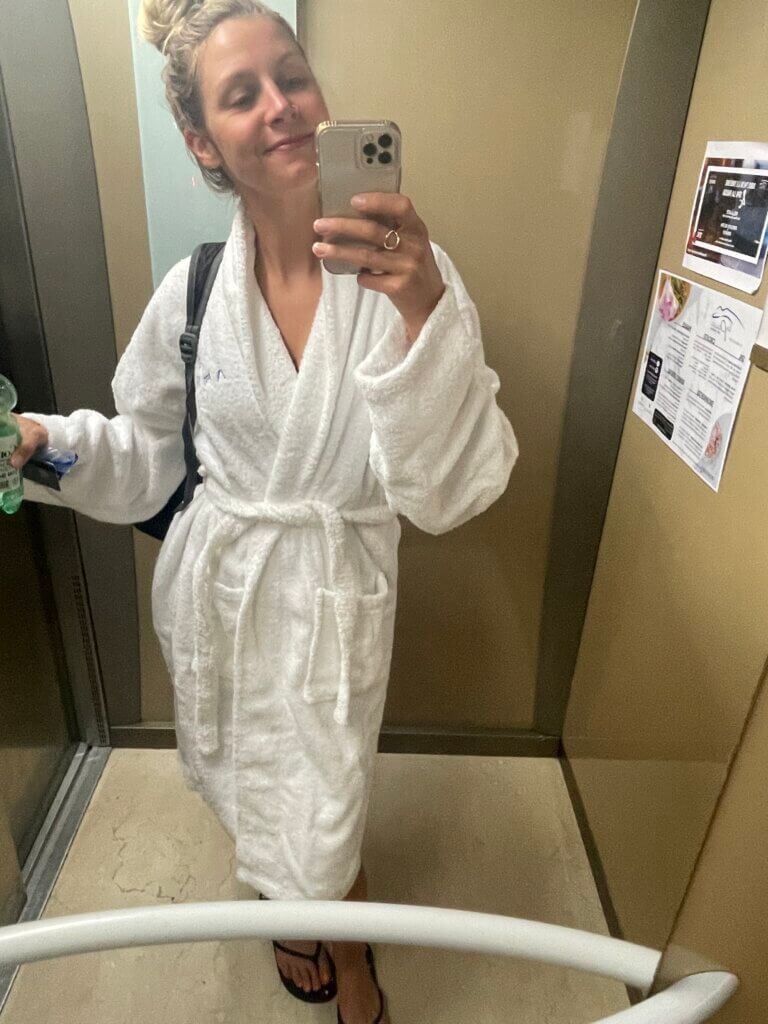
Ready for my spa treatment!
The Camino is beautiful. And it is ugly. It smells, it sweats, it is work. It is washing the laundry and hanging it to dry, day after day after day. It is step after step for miles upon dusty, rainy, sun-baked, monotonous miles. It is sleeping alone in bed in a room full of strangers. It is a uniform.
Take some treat days. Eat something exquisite. Bust the budget for a night in a private room. Dress up, just once, as much as possible. Sleep in, hit a museum, take a nap, mid-day, just because you can. Get a little drunk. Buy a souvenir. Rejoice in the feeling of walking without your pack.
The Camino is meant to be enjoyed, not only trudged through. The tiny villages and quiet mornings make you appreciate the bustle and noise of a big city. And likewise, the days spent touristing in luxury will provide the recharge you need. Suiting up in your gear, getting back to the Camino after a day of rest, will feel oddly like coming home. Variety is sweet. It is good to mix things up. Isn’t that why you’re walking across the whole of Spain to begin with?
Treat yourself. Afterward you can fill up your pack, and lace up your shoes, and get back to the business of being a pilgrim. Guilt-free. Rested. Ready.
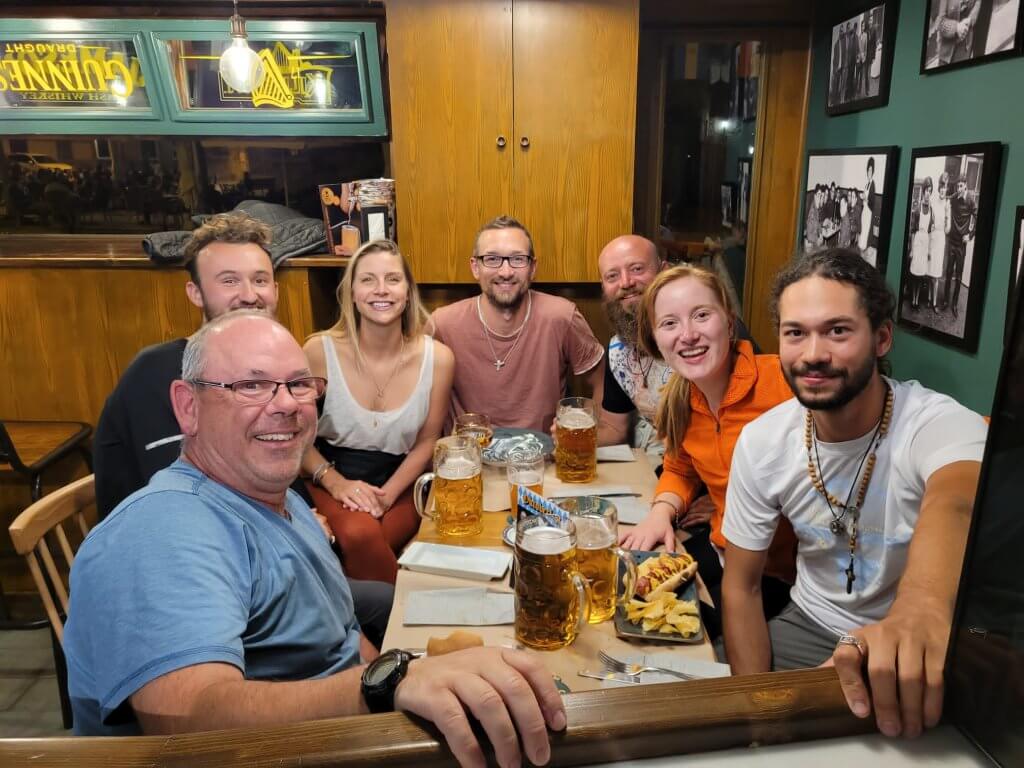
The Love Bubble was SO real in Astorga...
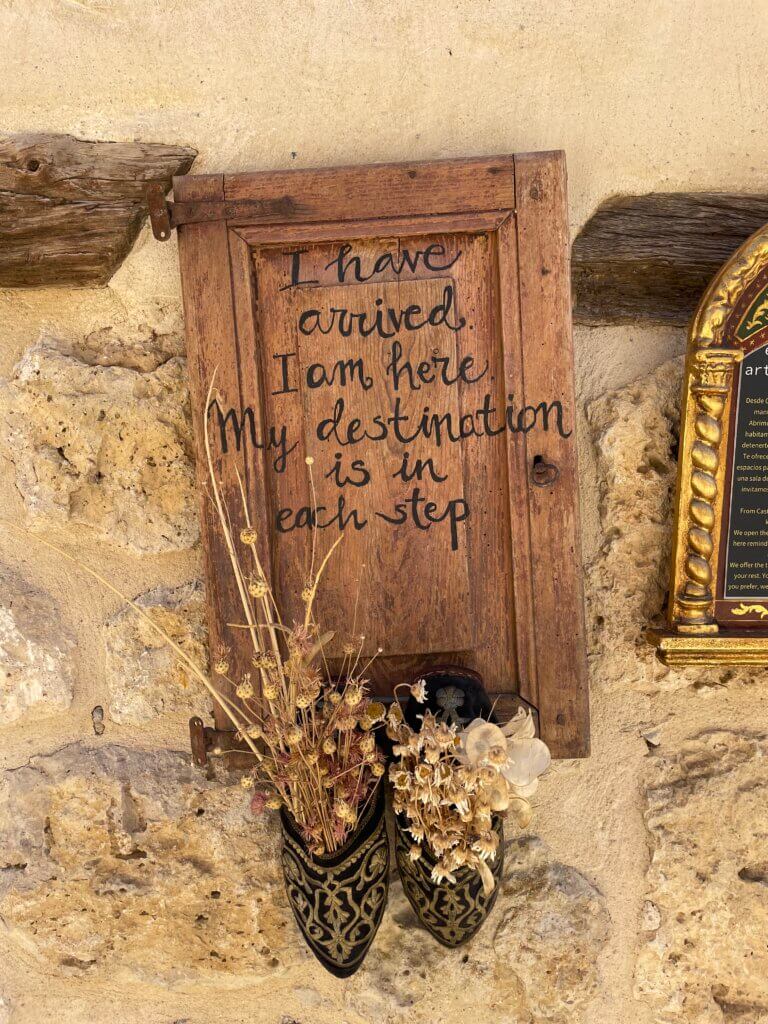
Over & Out
Well, future pilgrims, that is all I’ve got to say about accommodation on the Camino de Santiago.
I hope this post was helpful. If you have specific questions that weren’t answered, feel free to leave them in the comments or DM me on Instagram. I would love to hear from seasoned pilgrims out there—especially ones who did the Camino differently than I did. What accommodation style did you use most often? And why? And how did you like it? What was your best albergue experience—or worst?! Share with others looking for info and share with me so I can reminisce.
If you are getting ready to head off on your first Camino, know that no matter what type of accommodation you stay in, whether you book beds in advance or roll up last minute, whether you long for big cities or thrive in tiny villages, you will have an amazing experience on the Camino. It will be uniquely yours, a path unfolding in sometimes surprising ways. It will be just the journey you were meant to take. It will be right.
I am so excited for you. <3



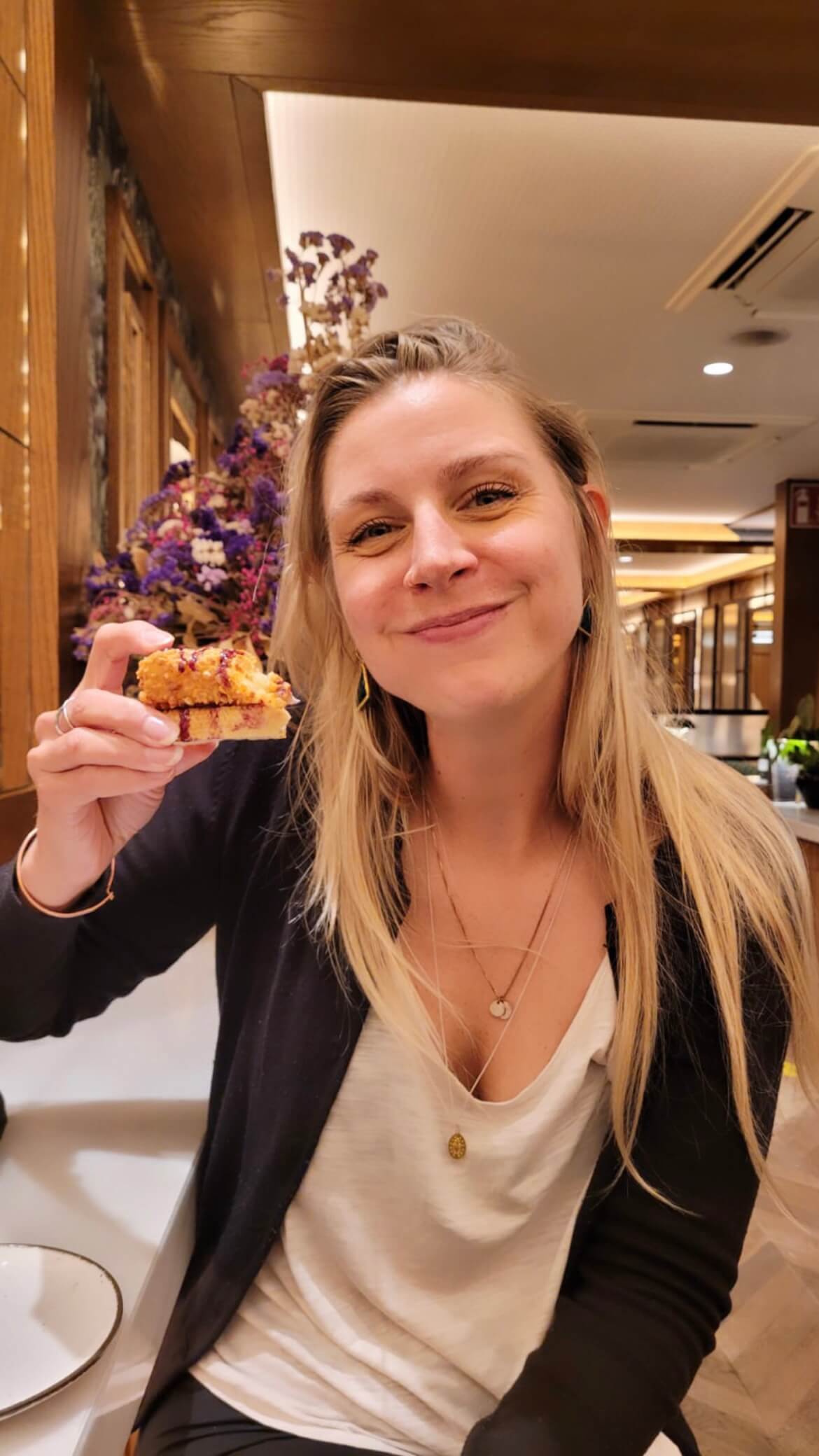
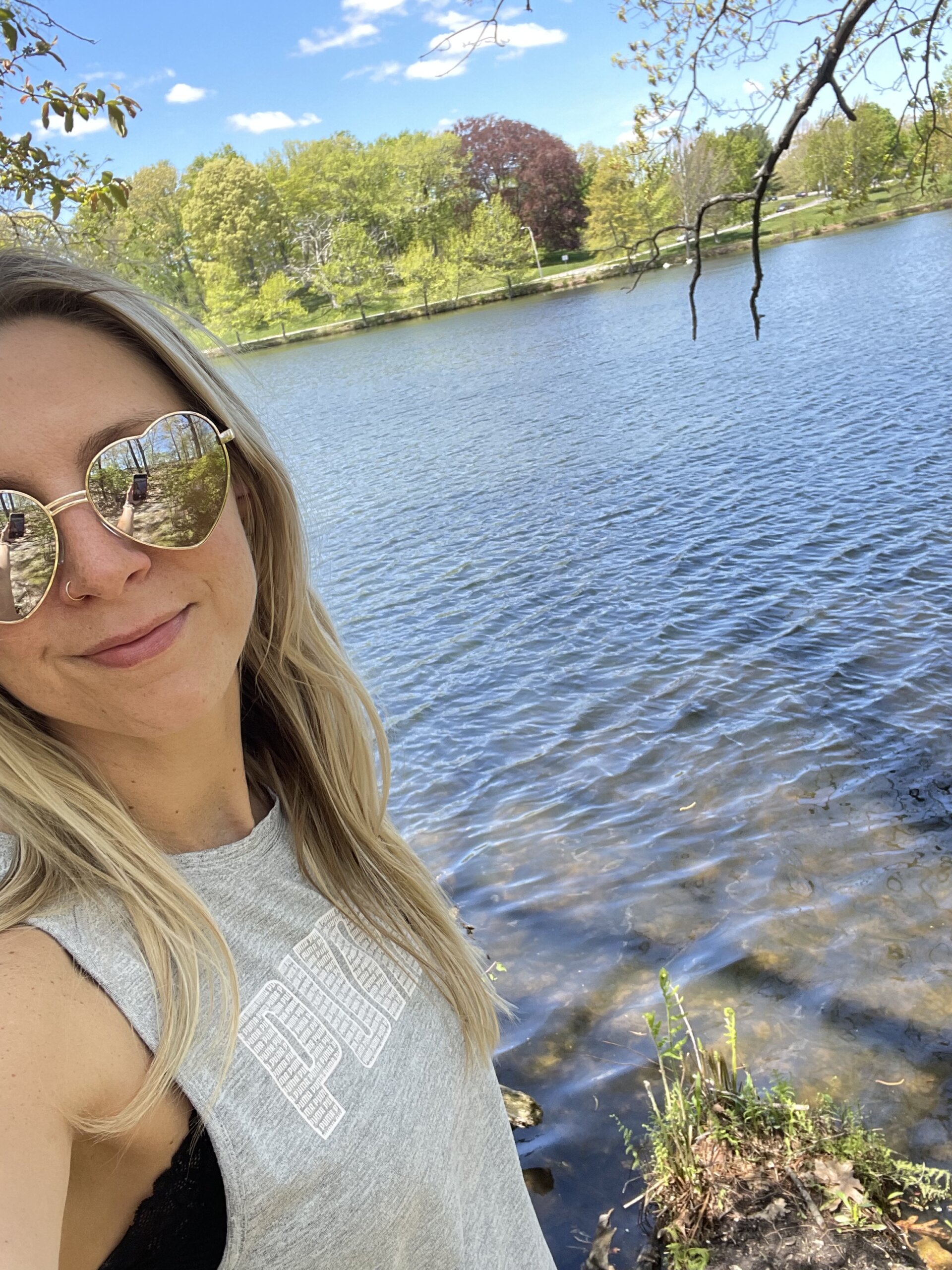
Rae
Wow, I didn’t expect to feel so much from this post. Reading through took me back to so many Marcos you sent me along the way. I truly feel like you brought me along with you. This post was so much more than accommodation advice. It was like experiencing the Camino first hand. Thanks Tone. <3
Toni
<3 Thanks for always being the first to read and comment, and for being there all along The Way. This post brought a LOT of nostalgia over here. What I would give to go back to last September and do it all over again. ::Le sigh::